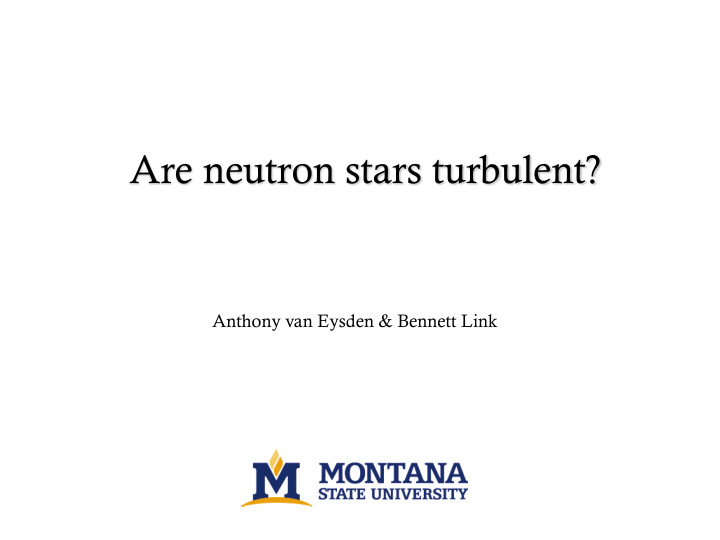



Are neutron stars turbulent? Anthony van Eysden & Bennett Link
Outline Neutron star observations Convective turbulence Rotation-powered instabilities General picture and conclusions
Neutron stars Ultra-compact stellar corpses Stable rotators Radio emission Crab Nebula
Neutron star interiors Outer crust for densities below nuclear saturation Outer core is nuclear fluid (5% protons and electrons) ? Inner core unknown Is this turbulent?
Magnetic field structure Pure dipole field is unstable (Flowers and Ruderman ‘77) Braithwaite and Spruit (2004) Only known stable configuration is the twisted torus Toroidal field at least equal to dipole field for stability
Why is turbulence interesting? Explain irregularities in radio timing data - Timing noise (e.g., Link 2012, Melatos & Link 2014) - Pulsar glitches (e.g., Melatos & Peralta 2007, Glampedakis & Andersson 2009, Andersson et al 2013) Gravitational wave emission - e.g., Melatos & Peralta 2010 - stochastic background (Lasky et al 2015)
Are neutron stars turbulent? Convective instability?
Convective turbulence Both the Sun and the Earth are convectively unstable
Neutron star cooling Neutron stars cool via neutrino emission (modified Urca process) ! + ! → ! + $ + % & + ̅ ( ) ! + $ + % & → ! + ! + ( ) n e Neutrinos free stream from interior Neutron star convectively stable (e.g., Gusakov and Kantor 2013, Passamonti et al. 2016)
Are neutron stars turbulent? Convective instability – neutrino cooled Kelvin-Helmholtz?
Kelvin-Helmholtz instability Two-stream interfacial instability v 1 v 2 Where? e.g, crust-core interface
Kelvin Helmholtz instability Add transverse field v 1 B v 2 No Effect!
Kelvin Helmholtz instability What about parallel field? v 1 B v 2 Stabilized my magnetic tension for Alfven speed, v A > v 1 -v 2
Are neutron stars turbulent? Convective instability – neutrino cooled Kelvin-Helmholtz – magnetic field stabilizes charged fluids Bulk two stream instabilities?
Neutron stars are cold Neutrons and protons form superfluid and superconducting condensates Neutron superfluid forms quantized vortex array to rotate Type II superconducting protons form quantized flux tube array to support magnetic field
Pinning interactions Vortex and flux tube arrays pin due to magnetic forces Proton-electron fluid (MHD fluid) Mutual friction (pinning) Neutron condensate (Inviscid fluid)
Spin-down equilibrium Superfluid neutrons W H t L DW Proton-electron plasma t Rotational lag develops between neutrons and protons Is this stable?
Bulk two-stream instability Perfectly pinned flux tubes and vortices v p v n Growth time ~ 1/( W n - W p ) (Glampedakis and Andersson 2009)
What about magnetic fields? Add poloidal (dipole field), what happens? B v p v n No effect!
What about magnetic fields? What about toroidal field? B v p v n Stabilized by magnetic stresses for Alfven speed, v A > v n -v p Corresponds to B=10 10 G --> stable!
Imperfect pinning Vortices excited by thermal fluctuations overcome pinning barriers – vortex slippage (Link 2014) Additional class of instabilities arise Slower growth rates (days) - timing noise? (Link 2012, Andersson et al 2013) Also stabilized by the magnetic field
Other two-stream instabilites? Unstable sound waves (chemical coupling)? - Relative flow for instability unrealistically high (e.g., Andersson et al. 2004) Entrainment (Fermi-liquid coupling)? - No instabilities in expected range of entrainment parameter (e.g., Andersson et al. 2004)
Are neutron stars turbulent? Convective instability – neutrino cooled Kelvin-Helmholtz – magnetic field stabilizes charged fluids Bulk two stream instabilities – stabilized by magnetic field Shear turbulence?
Shear turbulence Relative rotation between crust and core (e.g., Peralta & Melatos 2006,2007) Core composition unknown Decoupled from birth? (magnetic field) (Melatos 2012)
Are neutron stars turbulent? Convective instability – neutrino cooled Kelvin-Helmholtz – magnetic field stabilizes charged fluids Bulk two stream instabilities – stabilized by magnetic field Shear turbulence – if core magnetically decoupled Free precession?
Free precession Angular momentum vectors of protons and neutron misaligned Relative flow along the rotation axis Is this stable?
Stability of free precession Two stream instability B v p Stabilized by poloidal field for v n wobble angles < 1 degree (van Hoven and Levin 2008)
Stability of free precession Donnelly-Glaberson instability B v p v n Growth time of days to years
Are neutron stars turbulent? Convective instability – neutrino cooled Kelvin-Helmholtz – magnetic field stabilizes charged fluids Bulk two stream instabilities – stabilized by magnetic field Shear turbulence – if core magnetically decoupled Free precession – DGI growth time of days Anything else?
What’s driving turbulence? Magnetic braking is very weak
Conclusions Most candidate instabilities don’t appear to be relevant in neutron stars What can drive global, quasi-steady turbulence in a neutron star? Something we haven’t thought of?
Thanks!
Recommend
More recommend